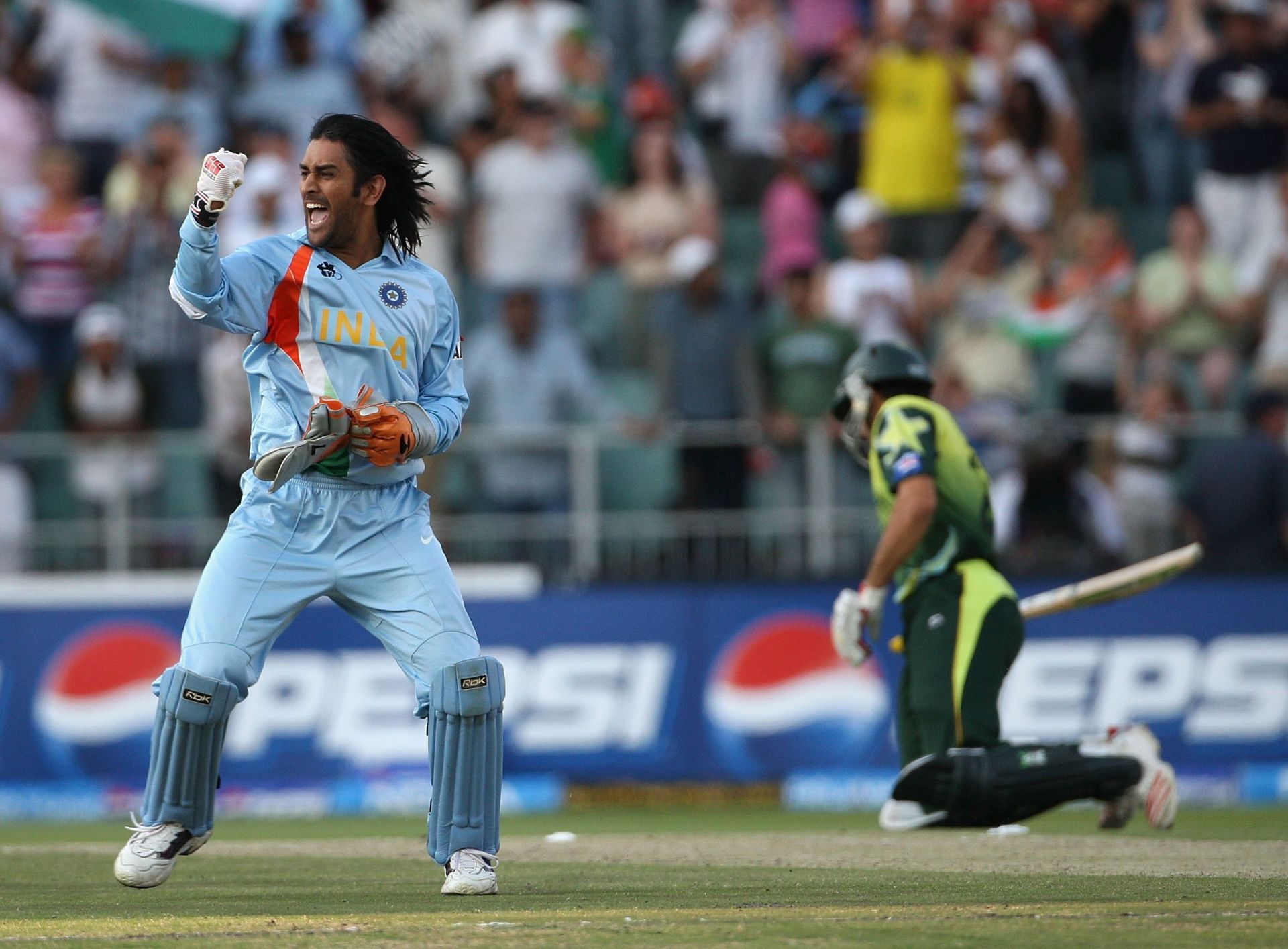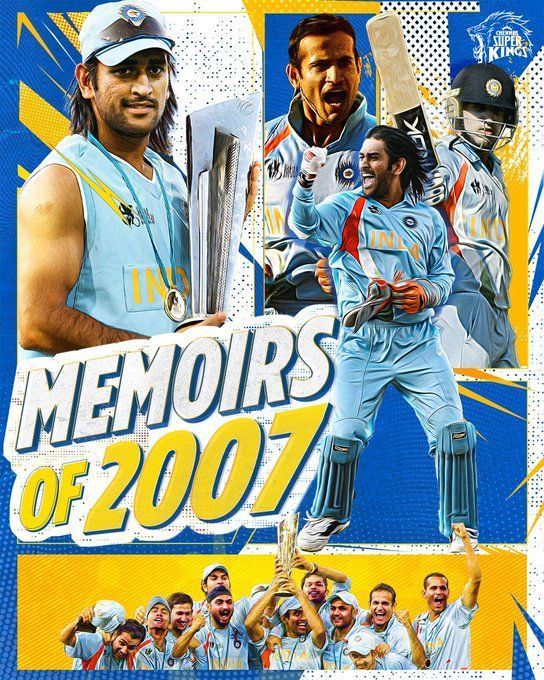
Reliving the day MS Dhoni's captaincy legend began
24th September, 2007, India, under MS Dhoni’s leadership, have reached the final of the inaugural edition of the T20 World Cup (ICC World T20 then). The Men in Blue have no business being here. Almost all of their marquee names are resting, awaiting bigger challenges and this group of youngsters, despite boasting the likes of Dhoni, Gautam Gambhir, Harbhajan Singh, Virender Sehwag and Yuvraj Singh, have not really been touted to achieve something special.
Yet, they find themselves here. In a summit clash against Pakistan, no less. Just months ago, India were acrimoniously dumped out of the 50-over World Cup, with a defeat to Bangladesh still fresh in the memory. So, as far as redemption arcs are concerned, this could become one of the greatest stories this sport has ever seen.
The Wanderers in Johannesburg is packed to the rafters. After every minute, some Indian fans break into an “India, India” chant. Pakistan fans provide an instant riposte, blurting out their respective rendition. Pakistan, much like India, were also eliminated at the group stage at the 50-over World Cup earlier in the year. The stakes, thus, are kind of high.
Amidst this frenzy, Dhoni and Shoaib Malik walk out for the toss. They can barely hear each other and the match referee. Once things have settled down (albeit very slightly), it comes to light that India have won the toss – a toss that could be crucial, considering the high-pressure environment. India, though, will have to do the unthinkable without Sehwag, who has unfortunately pulled up lame after the semi-final.
Yusuf Pathan is called into action and he immediately announces his arrival, smashing a six over Mohammad Asif’s head. This is just the second ball he is facing too, and at that very moment, you could sense something special was on the cards.
The game, as you might expect, has its ebbs and flows. Gambhir holds fort during the Indian innings, ensuring that they get up to a defendable total, even as those around him struggle for rhythm. Irfan Pathan gets into the act thereafter, snapping up three wickets in quick succession and pegging Pakistan back. As long as Misbah-ul-Haq is at the crease, though, Pakistan have a chance to win, and India have a chance to lose.
And then it all comes down to the final over. The equation, from Pakistan’s perspective, is very simple. 13 runs needed off 6 balls. One wicket in hand but importantly, Misbah is on strike. For India, too, the situation is pristinely clear. Pick one wicket and write yourself into eternal sporting folklore.
India have two options to bowl the final over. Harbhajan, who has played a truckload of international matches, and has largely held his own across formats. And, Joginder Sharma, who has only sparingly featured for India. Dhoni, by now, has developed a reputation of making the tough call seem routine. But this defining decision could shape how he, this Indian cricket team and the T20I format is looked at, forever. Pakistan win, and millions of Indians will wear a scar they will never be able to wash off.
Finally, Dhoni opts for Joginder, which at the time, seems a gamble. The first ball is a wide. The second is a dot but the third is clattered over the bowler’s head for six. Only six needed now off four balls, and Misbah has got the bit between his teeth. The next ball Joginder bowls is again on a length outside off – the sort of delivery that got pummelled just moments ago. This time, though, he has rolled his fingers and taken pace off, meaning that Misbah, who is attempting the scoop, mistimes it.
The ball goes miles up into the air and the sense of anxiety around the Wanderers is almost palpable. Pakistan fans are egging S Sreesanth to make a hash of it. Indian fans, meanwhile, are praying that he holds onto this catch, even if it means he drops every other catch that ever comes his way. And after a few seconds, which felt like an eternity, Sreesanth completes the catch and sends millions into ecstasy.
The celebrations, as expected, are off the charts. Once the dust has settled, though, people try to understand how and why Dhoni made the decision he did. Some critics, to this day, say that it was a massive gamble that just paid off. Dhoni has, almost always, listened to his instinct. It is part of what has made him what he is. But even in the most unrelenting of circumstances, his gut feeling was driven by remarkable cricketing awareness – something that often goes unnoticed during a game but makes plenty of sense after a period of time. Or, more precisely, after 15 years.
Joginder might have seemed a wildcard at the time. However, he had bowled the final over against Australia in the semi-final. He was selected primarily for his ability to bowl at the death, and Harbhajan, despite his experience, had been smacked to all parts by Misbah earlier in the encounter. It might have felt a gamble but it was possibly the safest option all along.
MS Dhoni made countless decisions under pressure
Dhoni made a habit of taking such decisions, especially as his legend, which first surfaced at Johannesburg in 2007, grew. The 2011 ICC Cricket World Cup has been dubbed by many as one of India’s greatest cricketing stories. Not many, though, thought Yuvraj would own the stage like he did. He had been battling form and injury. One person who did envision it was Dhoni, unlocking Yuvraj’s potential as a genuine all-rounder.
That World Cup, by the way, also saw Dhoni walking in ahead of Yuvraj in the final, despite the latter plundering runs for fun and the former huffing and puffing throughout the tournament. Again, it seemed as much a gut feeling call as any Dhoni had ever made. Deep down, he might have felt that it was his duty to lead from the front. Look closer, and you understand the logic behind it. It was not to steal the limelight or to just assert his authority. It was to primarily tackle Muttiah Muralitharan, with whom Dhoni had already played three seasons of IPL cricket.
Cast your mind back to the 2013 ICC Champions Trophy. India rocked up in England without knowing who would partner Shikhar Dhawan at the top of the order. Out came Rohit Sharma, probably because Dhoni knew how good he was against fast-bowling and that Rohit would get the luxury of taking a few deliveries at the start before exploding. The rest, as they say, is history.
In the final of that tournament, Ishant Sharma was leaking runs. He had given away 27 runs in his first three overs, and that was quite expensive, considering England were only chasing 130 in 20 overs. Dhoni had the option of calling upon one of Bhuvneshwar Kumar and Umesh Yadav, both of whom had already had an impact.
Yet, he persisted with Ishant. It could have been termed blind faith had India lost the game. But like it so often did in the matches that mattered, India didn’t. Ishant was carted for eight runs off the first two legal deliveries he bowled in the 18th over. He then hit back with two wickets, that too of Eoin Morgan and Ravi Bopara (both set batters). Ravichandran Ashwin and Ravindra Jadeja closed out the game and helped Dhoni win another ICC trophy as skipper.
Even on that disastrous Australia tour in 2011-12, Dhoni did something that would serve Indian cricket for years. After a string of failures, there were clamours to drop Virat Kohli. Sanjay Manjrekar even suggested giving him another game just to show that he could not make a career as a Test cricketer. Dhoni gave him that match, although with the confidence that he had it in him to sustain the rigours of Test cricket. A Kohli century at Adelaide followed, and it marked the arrival of an all-format behemoth.
He endured his fair share of troughs too. The 4-0 whitewashes in Australia and England will forever be a blot on his record and his inability to win the T20 World Cup at home in 2016 will remain a sticky point. These shortcomings, though, only told you that he was human, all while seeming a supernatural among mere mortals.
If you were a Dhoni fan, you would probably say he has had the Midas touch and that whatever he has touched, has more often than not turned into gold. His staunchest critics, however, would argue that he has been plain lucky and that he just had a good squad to adorn his captaincy skills.
But that’s the thing with Dhoni. He made so many of these decisions that putting it down to luck would be absurd. It was almost as if he made his own luck at times. And if anyone wishes to truly understand the genius or the method behind his madness, they need to go all the way back to Johannesburg and that manic evening against Pakistan at 2007.
India had no business being there. Dhoni had no business being there. He had no business ruling international white-ball cricket for the next six years. Yet, he and India did. Gut feeling, luck, pure instinct or each of these backed by immense game awareness – this debate could rage on and on. And on.
After 15 years of that historic T20 World Cup triumph, we are no closer to an answer. That might not change 15 years down the line either.

